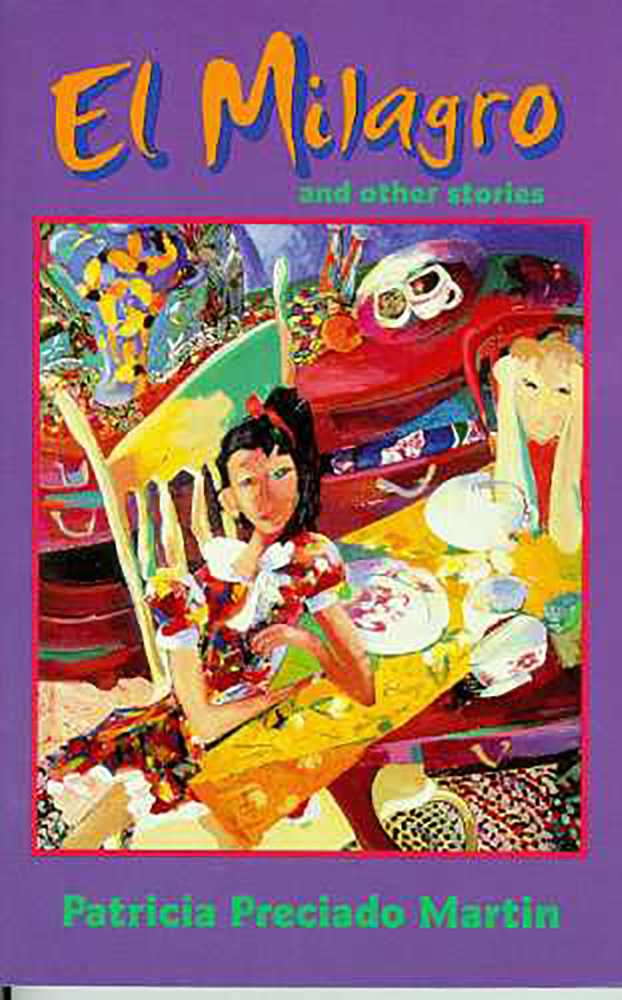El Milagro and Other Stories
Paperback ($16.95), Ebook ($16.95)
Buy
Ticking clocks and tolling bells, scents of roses and warm tortillas: this is the barrio of years past as captured in the words of Patricia Preciado Martin. Cuentos, recuerdos, stories, memories—all are stirred into a simmering caldo by a writer whose love for her heritage shines through every page.
Reminiscent of Like Water for Chocolate, the book is a rich mix of the simplest ingredients—food, family, tradition. We see Silviana striding to her chicken coop, triggering the "feathered pandemonium" of chickens who smell death in the air. We meet Elena, standing before the mirror in her wedding dress, and Teodoro Sánchez, who sleeps under the sky and smells of “chaparral and mesquite pollen and the stream bottom and the bone dust of generations. There’s the monsignor sitting on the edge of a sofa, sipping Nescafé from a china cup, and here is Sister Francisca "with her warm, minty breath" warning us away from impure thoughts. Be on your best behavior, too, in Tía Petra’s Edwardian parlor—la Doña Petrita, descended from conquistadores, might just deliver a tap on your head with her silver-handled walking stick. Then, with Mamacita, spend a summer afternoon bent over your embroidery with trembling hand and sweaty upper lip, and all the while wondering what in the world it feels like to be kissed.
Intermingled with the author’s stories are collective memories of the barrio, tales halfway between heaven and earth that seem to connect barrio residents to each other and to their past. These cuentos are mystical and dreamy, peopled with ghosts and miracles and Aztec princesses dressed in feathers and gold. Come, sit down and have some salsa and a tortilla—fresh and homemade, it goes without saying; people who buy tortillas at the market "might as well move to Los Angeles, for they have already lost their souls." Then open the pages of this book. Help yourself to another feast of food and flowers, music and dancing, sunshine and moonlight—everything glorious and mundane, serious and humorous, earthly and spiritual, poignant and joyful, in la vida mexicoamericana.
Reminiscent of Like Water for Chocolate, the book is a rich mix of the simplest ingredients—food, family, tradition. We see Silviana striding to her chicken coop, triggering the "feathered pandemonium" of chickens who smell death in the air. We meet Elena, standing before the mirror in her wedding dress, and Teodoro Sánchez, who sleeps under the sky and smells of “chaparral and mesquite pollen and the stream bottom and the bone dust of generations. There’s the monsignor sitting on the edge of a sofa, sipping Nescafé from a china cup, and here is Sister Francisca "with her warm, minty breath" warning us away from impure thoughts. Be on your best behavior, too, in Tía Petra’s Edwardian parlor—la Doña Petrita, descended from conquistadores, might just deliver a tap on your head with her silver-handled walking stick. Then, with Mamacita, spend a summer afternoon bent over your embroidery with trembling hand and sweaty upper lip, and all the while wondering what in the world it feels like to be kissed.
Intermingled with the author’s stories are collective memories of the barrio, tales halfway between heaven and earth that seem to connect barrio residents to each other and to their past. These cuentos are mystical and dreamy, peopled with ghosts and miracles and Aztec princesses dressed in feathers and gold. Come, sit down and have some salsa and a tortilla—fresh and homemade, it goes without saying; people who buy tortillas at the market "might as well move to Los Angeles, for they have already lost their souls." Then open the pages of this book. Help yourself to another feast of food and flowers, music and dancing, sunshine and moonlight—everything glorious and mundane, serious and humorous, earthly and spiritual, poignant and joyful, in la vida mexicoamericana.
"A sentimental and humorous remembrance of a genteel way of life that no longer exists in the Tucson Mexican community . . . Barrio Anita comes alive again through her interpretation of the words, thoughts, and behavior of its former inhabitants."—Journal of Arizona History
"A slender volume of lyrical vignettes and loving character studies . . . the stories are enlivened by colorful imagery and, in those spoken by their focal characters, racy individuality."—Kirkus Reviews
"Her blend of Spanish words, details and metaphors offers an affectionate depiction of life in a changing neighborhood."—Publishers Weekly
"This enchanting book will be enjoyed by young adults as well as adults."—Library Journal
"Were it not for Martin, the only history of Tucson that would see the light of day might be one primarily about people who were wealthy, from 'back East' and Anglo. In El Milagro . . . Martin continues to shine a light into the dark little corners of Tucson's history, the stories about Hispanic Tucsonans who grew up perhaps momentarily poor but nurtured by a rich, empowering and supportive culture."—Tucson Citizen
"A slender volume of lyrical vignettes and loving character studies . . . the stories are enlivened by colorful imagery and, in those spoken by their focal characters, racy individuality."—Kirkus Reviews
"Her blend of Spanish words, details and metaphors offers an affectionate depiction of life in a changing neighborhood."—Publishers Weekly
"This enchanting book will be enjoyed by young adults as well as adults."—Library Journal
"Were it not for Martin, the only history of Tucson that would see the light of day might be one primarily about people who were wealthy, from 'back East' and Anglo. In El Milagro . . . Martin continues to shine a light into the dark little corners of Tucson's history, the stories about Hispanic Tucsonans who grew up perhaps momentarily poor but nurtured by a rich, empowering and supportive culture."—Tucson Citizen
 The University of Arizona Press
The University of Arizona Press

